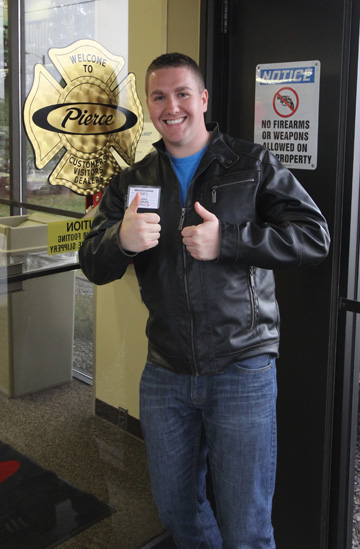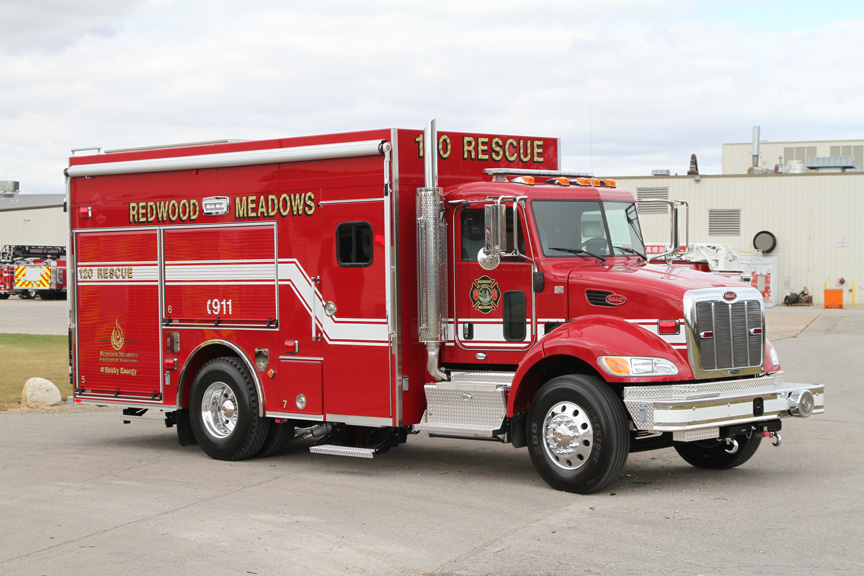
Features
Blogs
Size-up
Size-up
Oct. 15, 2012, Redwood Meadows, Alta. - Like all of us, I love this job. Yes, I don’t get paid for it but that is by choice for now. I grew up in a firefighting family and aside from getting my recent chief fire officer professional designation, bringing home a new truck for the department is one of the biggest thrills I’ve experienced.
October 15, 2012
By Rob Evans

|
|
| Capt./EMT Gary Robertson at Pierce Manufacturing in Appleton, Wis. Photo by Rob Evans. |
For a couple of days last week Capt./EMT Gary Robertson and I were at Pierce Manufacturing in Appleton, Wis., inspecting our latest acquisition. The new 120 rescue replaces an old City of Calgary ambulance that had been modified to carry our hydraulic rescue tools. Unfortunately, due to the size of the truck, or lack of, we were unable to carry all of our rescue tools on the one truck. Until now, the tools have been spread over two different trucks and our fire station.
This new truck is built on a Peterbilt 348 chassis and has lots of power with a 380-hp engine. We should have no troubles keeping up speed while traveling the hilly terrain and roadways in our response district. The compartment space on the truck is even more impressive than we had thought we had designed during the build process. I cannot emphasize enough the importance of ordering your trucks with enough shelving, trays, tool boards and whatnot for your equipment. Of course, there are lots of other items to keep in mind when building an apparatus. Whether it is a small department in which the chief makes all the decisions, or a larger, paid department with a truck committee, the process should not be taken lightly and time should be taken to properly design the truck for your department’s needs.
For Redwood Meadows Emergency Services (RMES), this truck will hold a variety of equipment and fill a number of roles for our response. This will be our busiest piece of apparatus, responding to more than two-thirds of all calls for RMES. Our EMTs and EMRs will use this as a primary-response vehicle for all of our medical co-responses. Cabinetry inside the crew area will hold a good supply of medical consumables and equipment for helping those in need before Alberta Health Services arrive with a paramedic crew. Medical bags, oxygen tanks, spine boards, a LP12 heart monitor and more will be carried inside. The inside of the crew area will also be used as a command center with a desktop on the back wall and a rehab area for our crews when needed, with auxiliary air conditioning and heating, a coffee maker, a fridge and snacks. This will work well with the awning that was added to the passenger side of the body. We also designed the crew area with the only entrance on the passenger side of truck, thereby keeping crews from entering and exiting on the traffic side of the truck.
The outside compartments of the truck will finally have everything we need: saws, fans, hand tools, hydraulic tools, cribbing, hazmat gear, air bags, stabilization struts and some more equipment that I’m sure I’m leaving out. Wow, what a change! Equipped with a 15-kilowatt PTO generator, we also have outlets around the truck, cord reels and a 6000-watt light tower that can be used to light up those very dark rural highway calls that we seem to get far too often. Overall, I think we have done a pretty good job of thinking about how this truck can improve the way we conduct our business.

|
|
|
|
If I could offer one last piece of advice for those departments buying new apparatuses in the future, regardless of the manufacturer: be involved in the build process. This includes researching similar apparatus types, visit factories and seeing how trucks are made, asking other departments about their experiences, attending pre-build meetings with your dealers and builders, demanding constant updates if they are not provided, and keeping lines of communication open with the dealer and builder. And last but not least, go to the factory at the end of the build and inspect your apparatus. Catch problems before the truck leaves the factory. You will not regret that little bit of extra time.
When my dad was chief of the Erin, Ont., fire department back in the 1970s, I remember him traveling to Pierreville, Que., to pick up the village’s new GMC/Thibault pumper to inspect and drive home. I still remember the smile on his face when he pulled back into town with the new truck. This truck will be our third new truck that I get to drive home from the dealer. I’m sure the smile on my face will be just as big! Man, I love this job.
Print this page